As you know from last week’s Post, we’ve left the problems of the world behind, and now we’re seeing the world. Which raises another problem:
Why is it so hard to get to church while we’re on vacation?

 It’s because we’re out of our routine which, as I said last week, is good for us – but often by the time we’ve remembered church it’s too late. Besides, in the US or anywhere in the Western world, a Divine Liturgy may be hard to find. And will it be in a language we understand? and will we be welcomed? * and are we dressed properly for it? and it will probably interrupt our vacation. It’s easier just to skip the whole thing, hoping that God will still be there when we get home. I know. I’ve done that. And I’ve found that for days afterwards I feel wrong. Not guilty. That’s a Roman Catholic / Protestant thing. We Orthodox don’t “do” guilt, at least not very well. It’s just that it leaves a big hole in my soul.
It’s because we’re out of our routine which, as I said last week, is good for us – but often by the time we’ve remembered church it’s too late. Besides, in the US or anywhere in the Western world, a Divine Liturgy may be hard to find. And will it be in a language we understand? and will we be welcomed? * and are we dressed properly for it? and it will probably interrupt our vacation. It’s easier just to skip the whole thing, hoping that God will still be there when we get home. I know. I’ve done that. And I’ve found that for days afterwards I feel wrong. Not guilty. That’s a Roman Catholic / Protestant thing. We Orthodox don’t “do” guilt, at least not very well. It’s just that it leaves a big hole in my soul.
- A couple from our Saint Nicholas, Cedarburg, with trepidation went to a very “old-country” Russian Orthodox Church with everything in Slavonic. Afterwards, to their surprise, they were met with the warmest of welcomes, as if they were long lost family. However, sometimes that does not happen. In that case, you learn that when you get home, you should always search out visitors at church and make them feel welcome.
 Please make the effort to go to church when you’re out of town. There’s something wonderful about worshiping God in new places. It’s interesting and enlightening to see what life is like in other Orthodox churches. Sometimes, when we encounter the same old Liturgy and the same old Orthodox Faith in a different environment, they come alive to us in new ways.
Please make the effort to go to church when you’re out of town. There’s something wonderful about worshiping God in new places. It’s interesting and enlightening to see what life is like in other Orthodox churches. Sometimes, when we encounter the same old Liturgy and the same old Orthodox Faith in a different environment, they come alive to us in new ways.
If you can’t find an Orthodox church, should you attend elsewhere? I’d say yes. You may find that God is there, too. Or you may come home extremely grateful to be Orthodox! Reminder: Orthodox people should not receive Holy Communion in non-Orthodox churches. * The Holy Eucharist to us is the sign of commitment to the Holy Orthodox Church and the Orthodox Faith – not just an expression of fellowship. Not to be crude, but it’s kind of like sex in marriage. We wouldn’t deny the validity of other peoples’ marriages, but we shouldn’t be “sleeping around”.
- Should I tell you this story? I know an Orthodox woman who attended a non-Orthodox service with a friend, went up front with her, took the Holy Wafer in her hand, and then thought “I shouldn’t be doing this”. But it was too late. So in a panic she put It in her pocket! But then what to do…? Do you want to hear the rest of the story? … … Just don’t get yourself into this situation!
Also keep in mind that in some Orthodox churches people still receive the Eucharist infrequently, and Confession and a considerable period of fasting are expected before. Follow the customs of the church you’re visiting. Take care not to offend anyone.
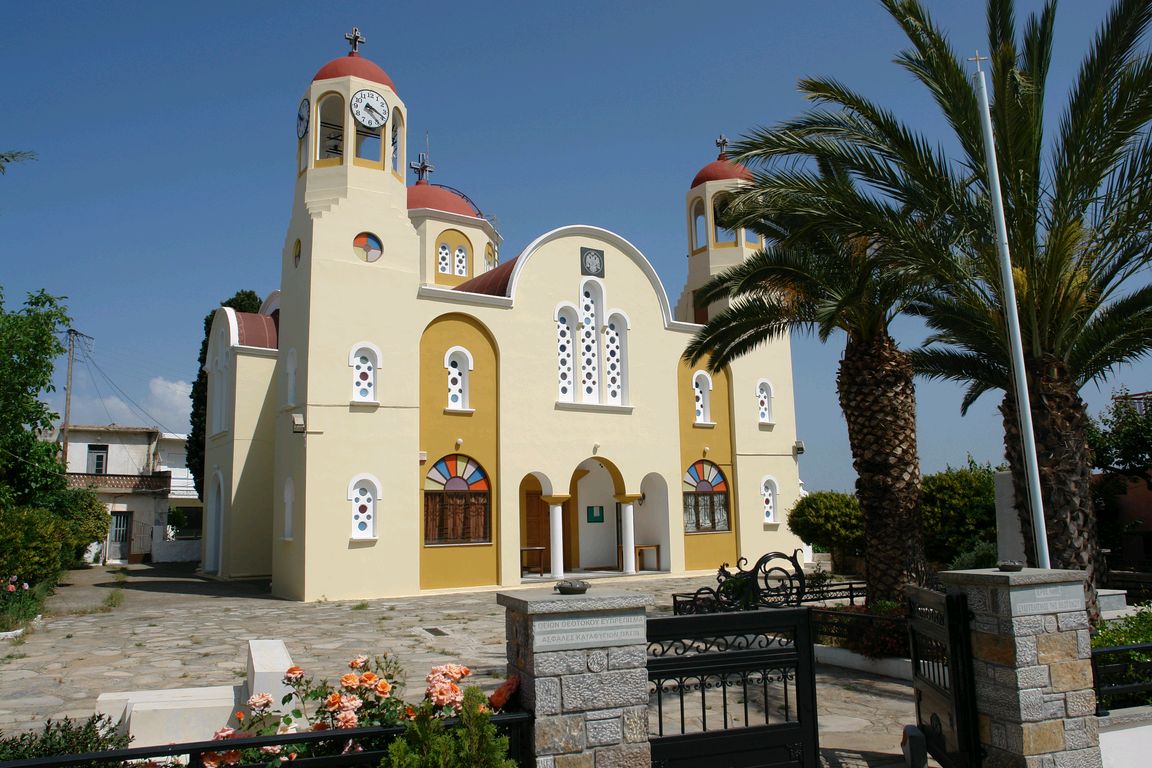 Anyway, the simple solution to our difficulty finding an Orthodox church is to go somewhere where there’s an Orthodox church around every corner. I would suggest Greece! In fact you’ve already been there with me for a week, and we’re now on Crete. So come along and find out what the Church there is like.
Anyway, the simple solution to our difficulty finding an Orthodox church is to go somewhere where there’s an Orthodox church around every corner. I would suggest Greece! In fact you’ve already been there with me for a week, and we’re now on Crete. So come along and find out what the Church there is like.
You don’t have to worry that people will stare at us, because when I’m on vacation I don’t wear my priestly garb. I want to see things as they really are, not as they are when people know a priest is watching.
Going to Church on Crete
I got to Divine Liturgy, as best I could, on Sundays and major feast days. I could feel it drawing me like a moth to the light.
As always, what struck me most about Orthodox worship 8000 miles from home, and in a language I scarcely know, was how much I felt at home. Some things were different: People participated very little verbally, though I could tell from their posture and signs of the Cross that they were involved. They received Holy Communion infrequently. And sermons were rare – a bad thing (though some people might count it a blessing!) but still in a country like Greece Orthodoxy is just “in the air”. Everything else was very familiar. “It’s time for the Great Entrance, so here comes the incense.” It would also have been familiar to people 1500 years ago, too. Orthodoxy is Orthodoxy is Orthodoxy. I love it.
Here were my adventures going to church.
1 Thursday September 8, Nativity of the Virgin: One of my favorite spots, Panaghia Kalyviani – the lovely women’s monastery complex out in the country just off the main highway in the Messara Plain, the “breadbasket” of Crete. I spent my first night in Crete near there just so I could go to Divine Liturgy next morning. I could even communicate with a nun! “τι ώρα είναι η λειτουργία?” “οκτώ”
The place has a happy feel about it, if you know what I mean. 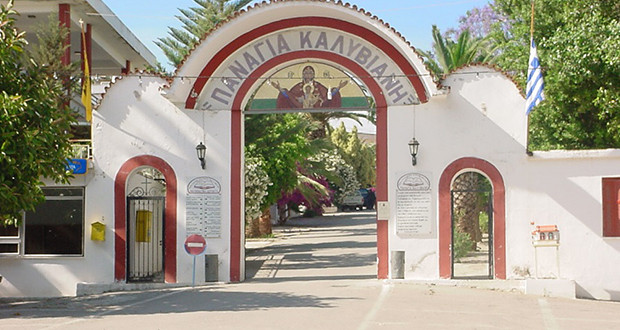 We enter the gates and go up the wide walk with blooming trees and chirping birds on both sides.
We enter the gates and go up the wide walk with blooming trees and chirping birds on both sides.
No isolated contemplative monastery, this. There’s an orphanage (with some handicapped children, I think), a hospice, a (feminists, close your ears for this one) “housekeeping school for girls”, an elementary school, a kindergarten, and at various times of year summer camps and workshops for weaving, knitting and making vestments, plus nuns all over the place – about forty of them, I would guess, but it’s hard to count. Nuns there seem to move around fast.
At this weekday Liturgy all of the above were represented, plus a lot of men and women 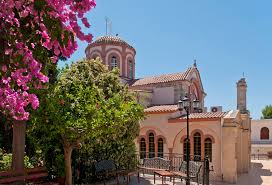 from the neighborhood. I lit candles for everybody at home, including one for a good friend who liked the place and who had died only a few days earlier. (+ Memory eternal, Angelica.) The large church was full to overflowing, and two pushy nuns kept packing more people in. It got too claustrophobic for me, so I moved back towards the entrance. The music was led by a very loud nun from somewhere behind a pillar. The Great Entrance featured a young man wearing a football shirt and an old nun carrying the incense. “Just like home”? Not.
from the neighborhood. I lit candles for everybody at home, including one for a good friend who liked the place and who had died only a few days earlier. (+ Memory eternal, Angelica.) The large church was full to overflowing, and two pushy nuns kept packing more people in. It got too claustrophobic for me, so I moved back towards the entrance. The music was led by a very loud nun from somewhere behind a pillar. The Great Entrance featured a young man wearing a football shirt and an old nun carrying the incense. “Just like home”? Not.
2 Sunday September 11: From the isolated taverna where I stayed next on the far south coast, it was thirty minutes up, back and forth, and over the mountain to Spili, the largest settlement for many 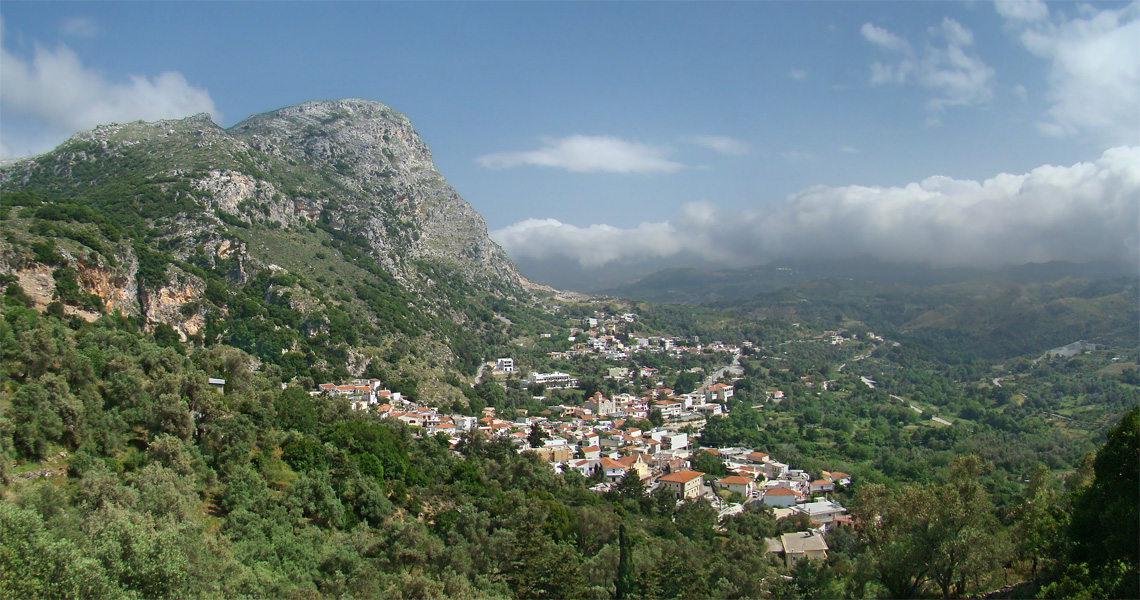 miles around, with only about 700 people. It’s a gorgeous place clinging onto the side of a mountain. Remember to use your parking brake! At the west end of town is the large Diocesan center below. Imagine that, in a country village! I discovered that during World War
miles around, with only about 700 people. It’s a gorgeous place clinging onto the side of a mountain. Remember to use your parking brake! At the west end of town is the large Diocesan center below. Imagine that, in a country village! I discovered that during World War 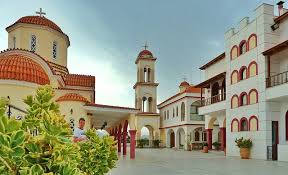 II, the Nazis kicked the bishop and his staff out and made it their headquarters. It was hard to imagine.
II, the Nazis kicked the bishop and his staff out and made it their headquarters. It was hard to imagine.
At the parish church in the center of the village the Divine Liturgy was beautifully served, with three priests and good chanting by a female cantor. On previous visits the church had been nearly full. This time there were fewer people and no youth at all – the most sparsely attended and disappointing Liturgy in all my years in Greece. Where was everybody?
3 Wednesday September 14, Elevation of the Holy Cross: Back to Spili again. No luck again. This time the church was locked. Nothing going on at the Diocesan center. I heard chanting coming from way up in the top of the village where there must have been a Holy Cross chapel. But I was scared to drive up those steep narrow streets for fear I’d never get out. (I’ve had a couple of very  unsettling experiences with that before.) I suppose I could have parked and climbed, but where? I couldn’t tell where the chanting was coming from.
unsettling experiences with that before.) I suppose I could have parked and climbed, but where? I couldn’t tell where the chanting was coming from.
So I got a cappuccino and a bougatsa (Greek pastry, which is to die for) and found good peanut butter of all things in the supermarket (in Greek, spelled “SUPERMARKET”!), so it wasn’t a total waste. Besides, our old Deacon John said his Scottish father had taught him that God rewards you for trying to get to church even if the door is locked. But I was disappointed. On this feast day, Greeks distribute great branches of basil, and I wanted to take some to my room and “bask” in the fragrance. Oh, well.
On the way back to the shore I saw one of the many little chapels open. This one was dedicated to Saint Nektarios! so I stopped and lit candles for everybody at home. *
- To any non-Orthodox reading this: Once, trying to be humorous, I told someone that the Orthodox religion consists chiefly of lighting and extinguishing candles! But really, to those who don’t understand, it sometimes can look that way. It’s not true, of course. Besides, within each flame there is a prayer.
4 Sunday September 18: That afternoon, Khouria Dianna was arriving at the airport in Iraklion, the “big” city of Crete with about 100,00 people. It turned out that friends Nicholas and Elizabeth (she was originally from our parish) were touring Greece and were in Iraklion that day only. Perfect! So I got up before dawn, hit the roads as soon as I could see the edges of the cliffs (this is important!) and drove two hours north into Iraklion.
I picked up Nick and Elizabeth at their hotel, and we went to Divine Liturgy at 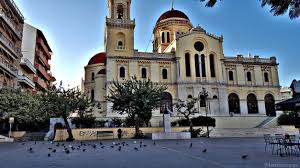 Saint Minas Cathedral, another very large church left filled to overflowing. Elizabeth could have stood with Nick and me on the right side with the men (a few
Saint Minas Cathedral, another very large church left filled to overflowing. Elizabeth could have stood with Nick and me on the right side with the men (a few 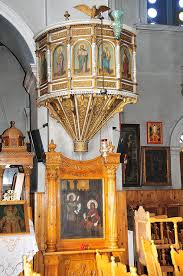 women were there) but she chose the traditional women’s left side. There was superb Byzantine chanting and Nick, who chants beautifully in English and Arabic, now sang along in Greek. (How does he do this?) The Gospel was sung from a lectern way high on a pillar toward the left side of the church. I want one of those! and an elevator to get me up there.
women were there) but she chose the traditional women’s left side. There was superb Byzantine chanting and Nick, who chants beautifully in English and Arabic, now sang along in Greek. (How does he do this?) The Gospel was sung from a lectern way high on a pillar toward the left side of the church. I want one of those! and an elevator to get me up there.
 After breakfast outdoors in the city center, we went exploring. First to Knossos the 4000 year old Minoan palace, which as always was covered with way too many tourists.
After breakfast outdoors in the city center, we went exploring. First to Knossos the 4000 year old Minoan palace, which as always was covered with way too many tourists.
Then we tried to go to a monastery high atop a mountain but I couldn’t find the road, so we drove aimlessly west along the north coast and were about to reverse course, when Nick spotted a sign pointing to a monastery. Why didn’t we try to find that? So we did.
It was about three kilometers south on a good road, which became a narrow paved road where we met many cars coming towards us. This turned into a very narrow gravel road with even more cars. We wondered what in the world could be going on back there in the hills. Finally we arrived at the little monastery to find cars parked all over, while on the grounds were many families, most of them picnicking with many children playing.
People were going into the church, so we also went along, lit candles and went up to venerate whatever they were  venerating. (Basic Orthodox rule: “If it holds still, kiss it!”) It was an octagonal silver container with glass on the top. Elizabeth asked What is it? I said It’s somebody’s skull, God only knows whose. She said What are the chances anybody speaks English here? I said Slim. Wisely ignoring me, Elizabeth asked a monk what it was, and he answered in good English “the skull of Saint Panteleimon”.
venerating. (Basic Orthodox rule: “If it holds still, kiss it!”) It was an octagonal silver container with glass on the top. Elizabeth asked What is it? I said It’s somebody’s skull, God only knows whose. She said What are the chances anybody speaks English here? I said Slim. Wisely ignoring me, Elizabeth asked a monk what it was, and he answered in good English “the skull of Saint Panteleimon”.
Panteleimon was a fourth century Unmercenary Physician and Martyr, one of the most popular of Greek saints. His skull was making the rounds for veneration and there it was, and there we were. Now, I don’t know how you feel about venerating skulls. (I’m ok with it now, but when I was Anglican I would have been horrified, just horrified.) But, really, how likely was it that we would find this major relic of one of the chief Greek saints just by chance, by driving down a back road? We were a bit in awe. I now ask Saint Panteleimon for his prayers (along with a bunch of other saints) before I go to sleep at night – if I can stay awake that long, that is.
We hurried back to the airport. I dropped off Nick and Elizabeth to fly on to wherever, and thirty minutes later here came Khouria Dianna with her smiling face, and off we went back to the beautiful south coast of Crete and the rest of our vacation. What a splendid day! I’ll never forget it.
5 Wednesday September 21: On a rainy day (fairly unusual for the south coast that early) we drove east to Gortyna, the ancient imperial capital city of Crete and Libya, which is across the Sea. (In those days the Mediterranean was the center of  civilization, not the edge thereof.) Gortyna was the see of Saint Andrew, Archbishop of Crete, author of the Great Lenten Canon. The city was destroyed by Saracens in the ninth century. There were virtually no fences and no tourists, so we wandered about unhindered in the silence. Broken columns, half-statues, homes and market buildings destroyed – a once great city now ruins, all ruins. “Sic transit gloria mundi.” And so someday shall be our glory, too. Travel in the ancient world helps us remember that.
civilization, not the edge thereof.) Gortyna was the see of Saint Andrew, Archbishop of Crete, author of the Great Lenten Canon. The city was destroyed by Saracens in the ninth century. There were virtually no fences and no tourists, so we wandered about unhindered in the silence. Broken columns, half-statues, homes and market buildings destroyed – a once great city now ruins, all ruins. “Sic transit gloria mundi.” And so someday shall be our glory, too. Travel in the ancient world helps us remember that.
Across the main highway is what’s left of Saint  Titus Cathedral which also is in ruins except for the altar. There’s a little table and sometimes a few candles burning. At a previous visit we even smelled incense.
Titus Cathedral which also is in ruins except for the altar. There’s a little table and sometimes a few candles burning. At a previous visit we even smelled incense.
Then we went on to the nearby village Aghia Deka (“Holy Ten”) and down a back street to 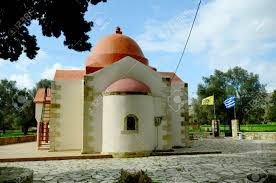 the Church of the Ten Martyrs of Crete who died in the third century persecution under the Emperor Decius. Their tombs are below, still venerated after almost 18 centuries. Some things do last.
the Church of the Ten Martyrs of Crete who died in the third century persecution under the Emperor Decius. Their tombs are below, still venerated after almost 18 centuries. Some things do last.
6 Sunday September 25: Khouria Dianna and I went to Divine Liturgy in the tiny village of Asomatos. The small church holds maybe fifty people max, no room for side aisles or even for a full iconostasis, 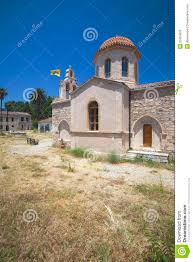 only one deacon’s door. This church was also full with a good proportion of men and young people. An ancient priest chanted very off key. (Will someone please tell me if I start to do that.) The parish priest preached a sermon! and much of the Anaphora was said aloud – hooray! In many Greek churches only small children regularly receive Holy Communion, but this priest had them receiving up to the mid teens. Another fifty years and maybe old people will be receiving the Holy Gifts there every Sunday! It was a prayerful “sweet” Liturgy. When we received the Antidoron at the end, the priest smiled and said “Welcome” in English. I guess we didn’t look like Greeks.
only one deacon’s door. This church was also full with a good proportion of men and young people. An ancient priest chanted very off key. (Will someone please tell me if I start to do that.) The parish priest preached a sermon! and much of the Anaphora was said aloud – hooray! In many Greek churches only small children regularly receive Holy Communion, but this priest had them receiving up to the mid teens. Another fifty years and maybe old people will be receiving the Holy Gifts there every Sunday! It was a prayerful “sweet” Liturgy. When we received the Antidoron at the end, the priest smiled and said “Welcome” in English. I guess we didn’t look like Greeks.
Well, I’ve rambled on and on again. It’s because I love Crete and I love having you here with me. I hope all the pictures have helped give you the “feel” of the place.
Next Week: Back to the Mainland, out to Aegina and Saint Nektarios, and then Home with some Reflections
Week after Next: the Holy Apostles Rocky Johnson and Paul

The first relic I ever venerated was a relic of St Panteleimon. It was before I was baptized and it was a very uncomfortable experience for me. However, I also timidly made a request of him, on behalf of my daughter who could not eat by mouth. Long story short, 3 years later she eats by mouth and has gained quite a bit of weight. But the best part of the story I only tell in person…
Greetings Father
Thank you for sharing your life with us. I am inspired to visit Greece someday. You seemed to say that you attended liturgies dressed as a layman. I am wondering about that. What made you decide that? Did you ever wear your cassock and what was the difference that made you decide to go incognito? Thank you again for sharing your perspectives and experiences.
I discovered long ago that if people know you’re a priest, nonbelievers tend to run the opposite direction and believers tend to fawn all over you. I wanted neither – partly so I could relax on vacation and just be me, partly so I could get to know and see people as they are. I’ve had a lot of good conversations this way that I would not have had otherwise, and have learned things I would not otherwise have learned. Besides, I didn’t know enough Greek to assist at Divine Liturgy.